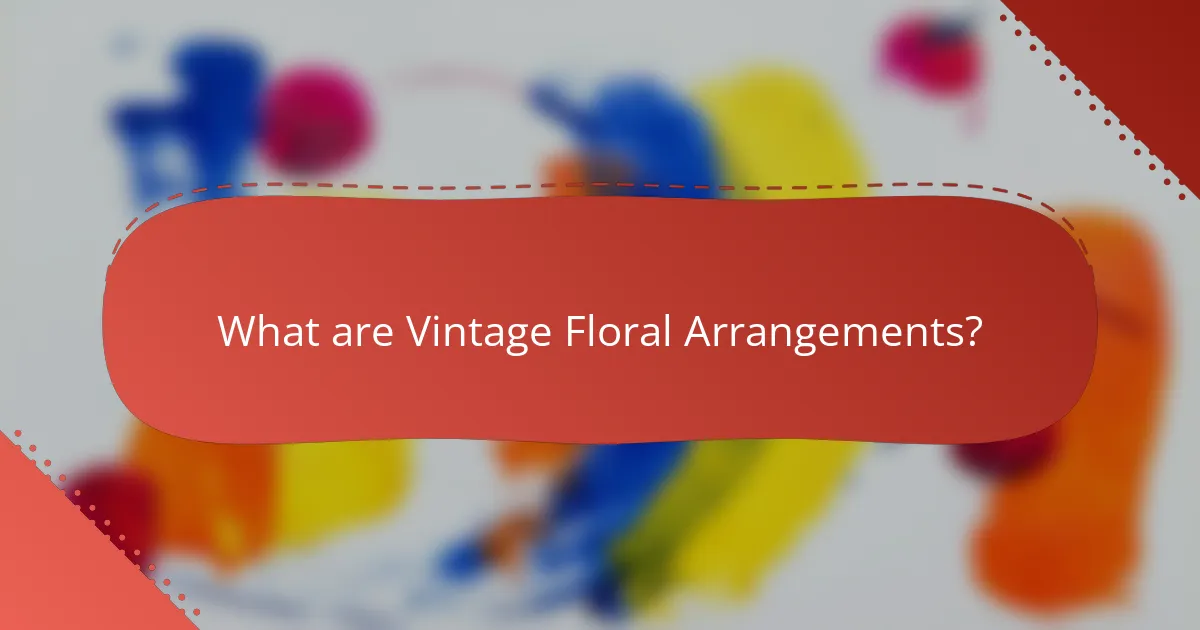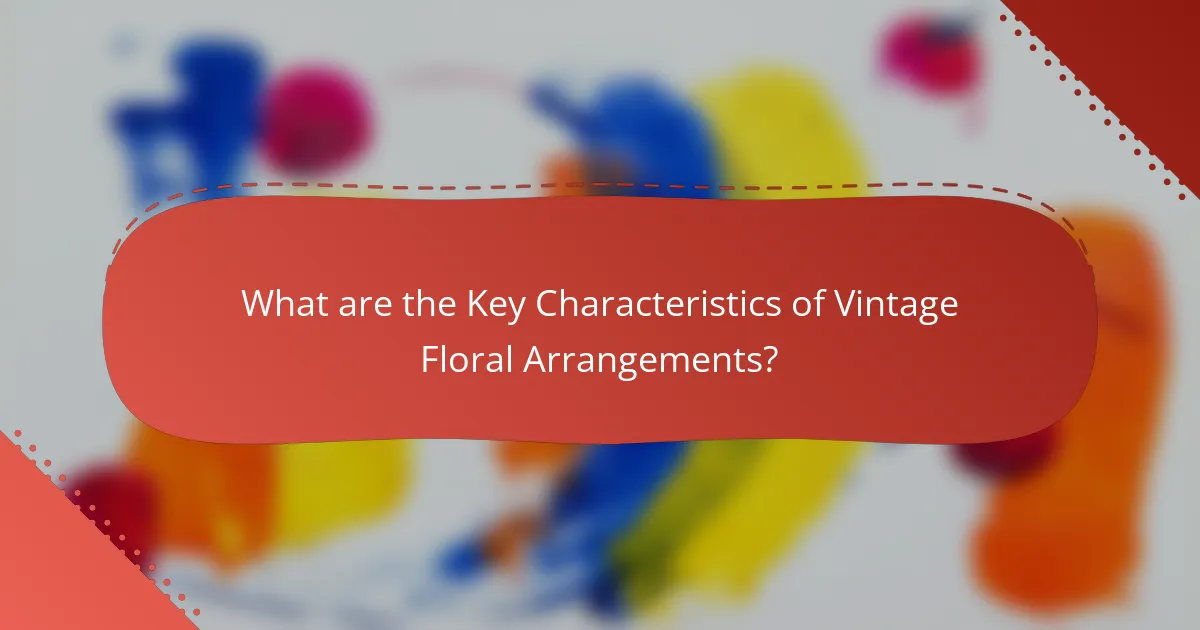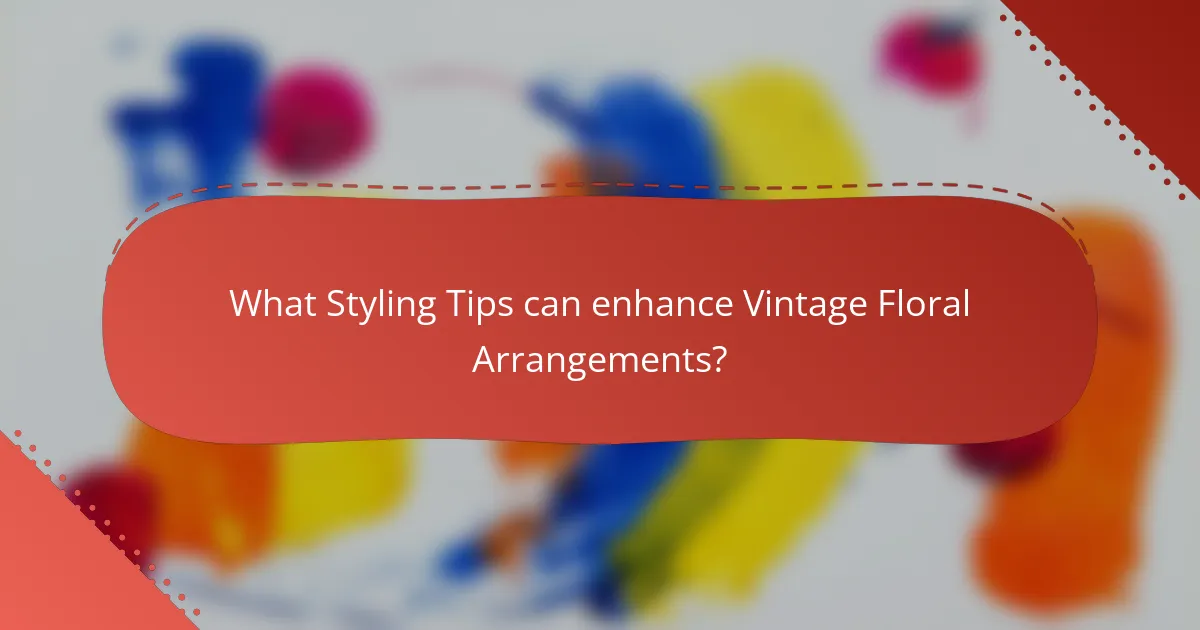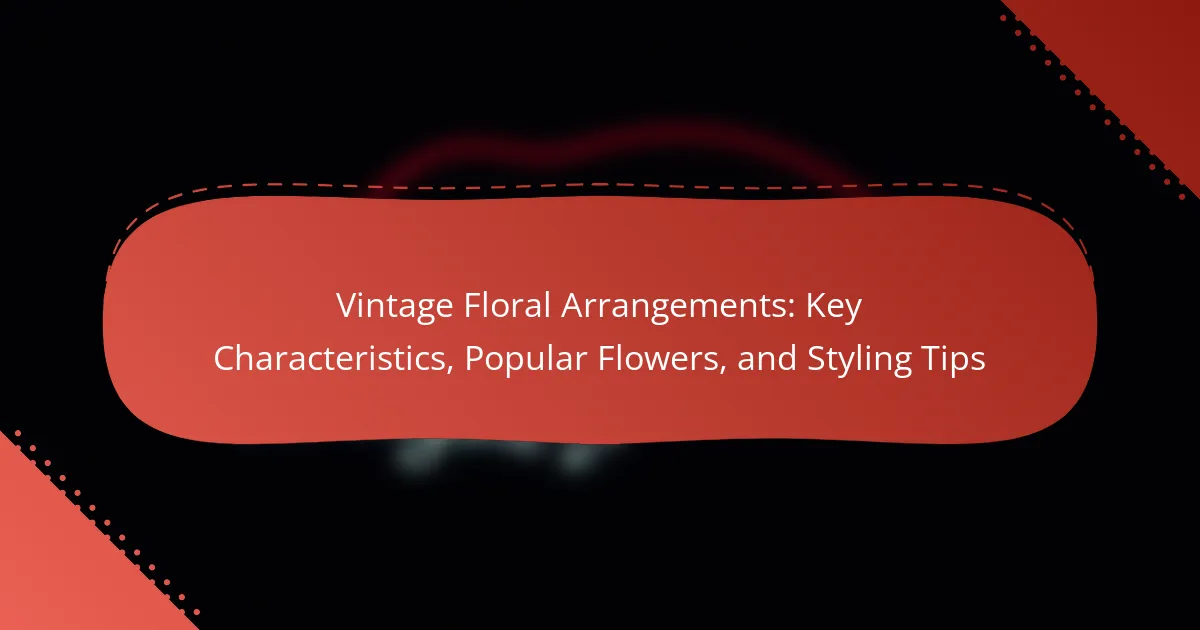
What are Vintage Floral Arrangements?
Vintage floral arrangements are decorative displays of flowers that evoke a sense of nostalgia and charm. They typically feature soft colors, lush textures, and a mix of various blooms. Common elements include peonies, roses, and hydrangeas, often arranged in a loose, organic style. These arrangements may also incorporate vintage containers like mason jars or antique vases. The aesthetic is inspired by historical floral design trends, particularly from the Victorian and Edwardian eras. The use of seasonal flowers enhances their authenticity and connection to a specific time period. Vintage floral arrangements are popular for weddings and special events, adding a romantic and timeless touch.
How do Vintage Floral Arrangements differ from modern styles?
Vintage floral arrangements typically emphasize a more romantic and nostalgic aesthetic. They often feature softer colors, such as pastels and muted tones. Common flowers in vintage arrangements include roses, peonies, and hydrangeas. These flowers are often arranged in a loose, organic style that mimics nature.
In contrast, modern floral arrangements tend to focus on bold colors and geometric shapes. They often use a limited variety of flowers, emphasizing a minimalist approach. Modern styles may incorporate unconventional materials, such as succulents or dried flowers. The arrangement is usually more structured and symmetrical compared to vintage styles.
Historical context shows that vintage styles draw inspiration from earlier periods, such as the Victorian era, which valued intricate designs. Modern styles reflect contemporary design principles that prioritize simplicity and functionality. This fundamental difference in design philosophy highlights how vintage arrangements evoke a sense of history while modern arrangements embrace current trends.
What historical influences shape Vintage Floral Arrangements?
Vintage floral arrangements are shaped by several historical influences. The Victorian era emphasized elaborate, sentimental designs. During this time, flowers were used to convey specific meanings through the language of flowers. The Art Nouveau movement introduced organic shapes and flowing lines in floral design. The post-World War II period saw a shift towards more casual arrangements influenced by the natural world. Additionally, traditional Japanese Ikebana has impacted the minimalist approach in vintage styles. Each of these influences has contributed to the aesthetic and cultural significance of vintage floral arrangements today.
What are the defining features of Vintage Floral Arrangements?
Vintage floral arrangements are characterized by a nostalgic aesthetic that emphasizes romantic and timeless designs. They often feature soft, muted color palettes that include pastels and earth tones. Commonly used flowers in these arrangements include roses, peonies, and hydrangeas, which evoke a classic feel. Additionally, vintage arrangements often incorporate unique elements like lace, burlap, or antique vases. The arrangement style tends to be loose and organic, creating an effortless look. Furthermore, vintage floral designs frequently reflect historical influences, drawing inspiration from different eras. These features collectively create a charming and elegant presentation that appeals to those seeking a vintage-inspired decor.
Why are Vintage Floral Arrangements popular today?
Vintage floral arrangements are popular today due to their nostalgic appeal and unique aesthetic. These arrangements evoke a sense of timelessness and charm. They often feature soft color palettes and a mix of textures. This style resonates with those seeking to create warm and inviting spaces. Additionally, vintage arrangements can complement various decor styles, from rustic to elegant. The resurgence of interest in sustainable practices has led to a preference for locally sourced, seasonal flowers. This trend aligns well with the vintage aesthetic, emphasizing natural beauty. Furthermore, social media platforms showcase these arrangements, increasing their visibility and popularity.
What occasions commonly feature Vintage Floral Arrangements?
Vintage floral arrangements are commonly featured at weddings, anniversaries, and tea parties. They evoke a sense of nostalgia and elegance suitable for romantic occasions. Additionally, vintage arrangements are popular at bridal showers and garden parties. They can also enhance home decor during seasonal celebrations. Events that emphasize rustic or vintage themes often incorporate these arrangements. Their historical appeal makes them a favorite for milestone birthdays. Overall, vintage floral arrangements add charm to various special occasions.
How do Vintage Floral Arrangements evoke nostalgia?
Vintage floral arrangements evoke nostalgia through their classic designs and historical significance. These arrangements often feature flowers and colors popular in past eras. Common flowers include peonies, roses, and daisies, which were widely used in vintage decor. The use of muted color palettes also contributes to a sense of the past. Additionally, vintage arrangements often utilize traditional techniques, such as hand-tied bouquets or compote vases. These elements remind individuals of personal memories or cultural heritage. Studies show that scents and visuals can trigger memories, reinforcing the nostalgic feelings associated with vintage designs. Overall, the combination of historical elements and personal connections makes vintage floral arrangements a powerful source of nostalgia.

What are the Key Characteristics of Vintage Floral Arrangements?
Vintage floral arrangements are characterized by their nostalgic aesthetic and use of soft, muted colors. They often incorporate a mix of flowers, including peonies, roses, and hydrangeas. These arrangements typically feature asymmetrical designs that create a relaxed, organic look. Textures play a significant role, with the inclusion of greenery and filler flowers enhancing depth. Vintage arrangements may also utilize antique or rustic containers, such as mason jars or wooden boxes. They often evoke a sense of romance and charm, making them popular for weddings and special events. Historical influences from different eras, particularly the Victorian period, shape their style and flower selection.
What types of flowers are commonly used in Vintage Floral Arrangements?
Roses, peonies, and hydrangeas are commonly used in vintage floral arrangements. These flowers evoke a sense of nostalgia and elegance. Roses are favored for their classic beauty and variety of colors. Peonies add a lush, romantic touch with their large blooms. Hydrangeas provide volume and texture, enhancing the overall arrangement. Other popular choices include lilacs, dahlias, and gardenias, all contributing to the vintage aesthetic. Their historical significance in floral design further supports their use in this style.
Which flowers symbolize vintage aesthetics?
Roses symbolize vintage aesthetics. They evoke nostalgia and romance, commonly used in vintage floral arrangements. Peonies also represent vintage charm, known for their lush blooms and soft colors. Hydrangeas add a classic touch, often found in antique gardens. Sweet peas are delicate and fragrant, embodying vintage elegance. Lastly, lavender brings a rustic feel, frequently associated with vintage themes. These flowers collectively enhance the vintage aesthetic in floral design.
How do seasonal flowers play a role in Vintage Floral Arrangements?
Seasonal flowers are essential in vintage floral arrangements as they enhance authenticity and aesthetic appeal. Using flowers that are in season aligns with traditional practices, reflecting the natural cycles of growth. This choice adds a sense of nostalgia and connection to the past. Seasonal flowers often boast richer colors and fresher scents, elevating the overall sensory experience. For instance, peonies in spring or chrysanthemums in autumn can evoke specific memories or emotions. Additionally, they are typically more cost-effective and sustainable, as they require less transportation. The inclusion of seasonal varieties ensures that arrangements are not only beautiful but also environmentally conscious.
What design principles are essential for creating Vintage Floral Arrangements?
Essential design principles for creating Vintage Floral Arrangements include balance, harmony, and texture. Balance ensures that the arrangement feels stable and visually appealing. Harmony involves selecting flowers and colors that complement each other, creating a cohesive look. Texture adds depth and interest, using a mix of smooth and rough elements. Proportion is also crucial; each flower type should relate well in size to others. Additionally, using asymmetry can evoke a natural, organic feel typical of vintage styles. Finally, incorporating seasonal and locally sourced flowers enhances authenticity. These principles are foundational for achieving the desired vintage aesthetic in floral design.
How does color palette influence Vintage Floral Arrangements?
Color palette significantly influences vintage floral arrangements by dictating their overall aesthetic and emotional appeal. The choice of colors can evoke nostalgia, warmth, and elegance, which are key characteristics of vintage styles. Soft pastels, muted tones, and rich jewel colors are commonly used to create a vintage look. These colors enhance the perception of age and timelessness in the arrangement. For instance, shades like dusty pink and lavender are often associated with vintage aesthetics. Additionally, color combinations can impact the visual balance and harmony of the arrangement. Research shows that complementary colors create a pleasing visual effect, enhancing the arrangement’s appeal. Ultimately, the color palette is essential in defining the vintage floral arrangement’s style and emotional resonance.
What are the common shapes and structures in Vintage Floral Arrangements?
Common shapes in vintage floral arrangements include round, cascading, and asymmetrical designs. Round arrangements feature a dome shape, creating a balanced look. Cascading designs have flowers that flow downward, mimicking a waterfall effect. Asymmetrical arrangements are more free-form, focusing on visual interest rather than symmetry.
Structures often incorporate varied heights and textures. This adds depth to the arrangement. Additionally, vintage styles frequently use natural materials like burlap or lace for a rustic feel. These elements enhance the overall vintage aesthetic. Historical references indicate that these shapes were popular in the Victorian era, emphasizing elegance and romance.

What Styling Tips can enhance Vintage Floral Arrangements?
To enhance vintage floral arrangements, consider using a mix of textures and colors. Combining soft pastels with deep, rich hues creates visual interest. Incorporating varied foliage adds depth and contrast. Using vintage containers, like mason jars or ornate vases, complements the theme. Adding elements like lace or burlap can enhance the rustic feel. Grouping flowers in clusters rather than evenly spaced allows for a more organic look. Incorporating dried flowers or herbs can introduce unique shapes and scents. Lastly, consider the arrangement’s height and balance to create a visually pleasing display.
How can one choose the right container for Vintage Floral Arrangements?
To choose the right container for vintage floral arrangements, consider the style and material of the container. Vintage arrangements often benefit from containers that reflect a classic or rustic aesthetic. Materials like glass, ceramic, or aged metal enhance the vintage look. The size of the container should complement the flowers used; larger arrangements require bigger containers. Additionally, the color of the container should harmonize with the floral palette. Textured surfaces can add depth and interest to the arrangement. Finally, ensure the container has proper drainage to maintain flower longevity.
What materials work best for vintage-inspired containers?
The best materials for vintage-inspired containers include glass, metal, ceramic, and wood. Glass offers a classic look and allows visibility of the contents. Metal containers, such as tin or galvanized steel, provide a rustic charm. Ceramic containers often feature intricate designs and colors that enhance vintage aesthetics. Wood adds a natural, warm touch that complements floral arrangements. These materials are commonly used in vintage decor, as they evoke nostalgia and timelessness.
How does container shape affect the overall arrangement?
Container shape significantly affects the overall arrangement of flowers. Different shapes influence the visual balance and structure of the floral design. For instance, tall, narrow containers emphasize verticality and can create a more dramatic effect. Conversely, wide, shallow containers promote a spread-out arrangement that appears more relaxed.
The shape also dictates the placement of flowers. Round containers encourage circular arrangements, while angular shapes can lead to more structured designs. Additionally, the container’s shape can affect how flowers are perceived from various angles. Research shows that arrangements in uniquely shaped containers can enhance aesthetic appeal and draw attention to specific blooms.
What are some practical tips for arranging flowers in a vintage style?
To arrange flowers in a vintage style, use soft, muted colors and varied textures. Choose flowers like peonies, roses, and hydrangeas for a classic look. Incorporate greenery such as ferns or eucalyptus for added depth. Use vintage containers like mason jars or antique vases to enhance the aesthetic. Arrange flowers loosely for a more natural appearance. Add elements like lace or burlap to complement the vintage theme. Consider the height and shape of the arrangement, aiming for an asymmetrical design. Finally, include personal touches, such as family heirlooms, to create a unique vintage feel.
How can layering and texture improve a Vintage Floral Arrangement?
Layering and texture enhance a Vintage Floral Arrangement by adding depth and visual interest. Layering involves arranging flowers and foliage at varying heights and densities. This technique creates a more dynamic and engaging display. Texture introduces different surface qualities, such as smooth petals alongside rough foliage. The contrast in textures draws the eye and invites closer inspection.
Using various flower types, like peonies and eucalyptus, contributes to this effect. Peonies provide a lush, full appearance, while eucalyptus adds a delicate, feathery touch. Together, they create a balanced composition. Incorporating vintage elements, such as lace or burlap, can further enhance the arrangement’s nostalgic appeal. These materials complement the floral textures, enriching the overall aesthetic.
What finishing touches can enhance the vintage feel of an arrangement?
Incorporating lace accents can enhance the vintage feel of an arrangement. Lace adds a delicate, nostalgic touch that evokes a sense of history. Using antique vases or containers also contributes significantly. These items often feature intricate designs that reflect bygone eras. Adding dried flowers or herbs introduces a rustic element. Dried elements provide texture and a sense of timelessness. Utilizing muted color palettes further enhances the vintage aesthetic. Soft pastels and earth tones create a harmonious, aged look. Finally, including vintage-inspired ribbons can tie the arrangement together. Ribbons in soft fabrics like silk or cotton add elegance and charm.
What common mistakes should be avoided when creating Vintage Floral Arrangements?
Common mistakes to avoid when creating vintage floral arrangements include using overly bright colors. Vintage arrangements typically feature muted, soft tones. Ignoring the balance of flowers can also lead to an unappealing look. Each flower should have its place to create harmony. Another mistake is neglecting texture variety. Mixing different flower types adds depth and interest. Overcrowding the arrangement can detract from its vintage aesthetic. Allowing space between flowers enhances visual appeal. Lastly, failing to consider the container can impact the overall style. Vintage containers should complement the flowers, not clash with them.
How can one prevent overuse of modern elements in Vintage Floral Arrangements?
To prevent overuse of modern elements in vintage floral arrangements, focus on traditional flowers and materials. Use heirloom varieties like peonies, garden roses, and sweet peas. Incorporate vintage-inspired containers such as ceramic vases or glass compotes. Limit the use of sleek, contemporary designs that detract from the vintage aesthetic. Emphasize soft, muted color palettes that reflect historical trends. Avoid synthetic materials and opt for natural elements like burlap or lace. Research shows that authentic vintage arrangements often feature asymmetry and a relaxed style, which helps maintain the vintage feel.
What are the pitfalls of color mismatches in Vintage Floral Arrangements?
Color mismatches in vintage floral arrangements can disrupt aesthetic harmony. This can lead to visual disarray, making the arrangement less appealing. Inconsistent color palettes may clash, causing certain flowers to stand out awkwardly. This results in a lack of cohesion that detracts from the overall design. Additionally, color mismatches can confuse the intended mood or theme. For instance, a vibrant hue may overpower softer tones, altering the arrangement’s vintage charm. Research has shown that color theory plays a crucial role in floral design. Proper color combinations enhance emotional responses and visual balance. Therefore, avoiding color mismatches is essential for achieving a successful vintage floral arrangement.
Vintage floral arrangements are decorative displays characterized by their nostalgic aesthetic, featuring soft colors, lush textures, and a mix of blooms such as peonies, roses, and hydrangeas. This article covers the key characteristics of vintage arrangements, including their historical influences, common flower types, and essential design principles. It also provides styling tips to enhance these arrangements, discusses the importance of seasonal flowers, and highlights the significance of container choice. Additionally, the article addresses common mistakes to avoid and offers insights into how to maintain the vintage appeal while creating floral designs.
